|
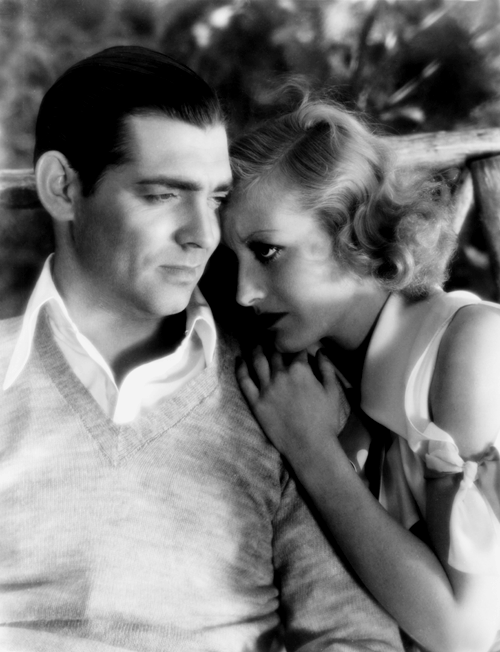
""Laughing Sinners" was good for me - I danced well, acted well, and hit off a few sparks, on screen and off,
with and up-and-coming young actor named Clark Gable." -Joan Crawford
"Laughing Sinners" 1931
Cast: Cast: Joan Crawford (as Ivy 'Bunny' Stevens), Neil Hamilton, Clark Gable, Marjorie Rambeau, Guy Kibbee, Cliff Edwards,
Roscoe Karns, Gertrude Short,
George Cooper, George F. Marion, Bert Woodruff.
Release date - May 30, 1931
Running time - 71 minutes (8 reels)
Directed by - Harry Beaumont
Writing Credits - Edith Fitzgerald (additional dialogue), Martin Flavin (dialogue), Bess Meredyth and Kenyon Nicholson
(for the play, Torch Song)
Producer - Unknown
Cinematographers - Charles Rosher, George Nogle, Roy Noble (Asst. cam)
and Harry Marble (Asst. cam)
Costumes - Adrian
Studio - MGM
Production Began - Early February, 1931
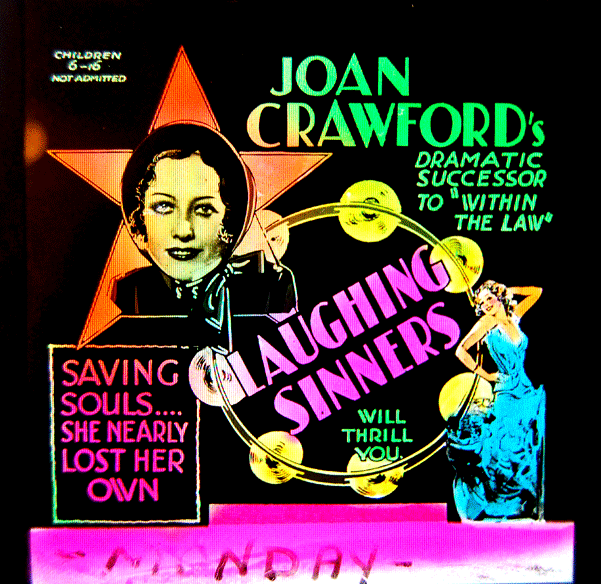
Movie Synopsis
Ivy "Bunny" Stevens (Joan) is a chorus girl, who falls for the sleazy salesman, Howard "Howdy" Palmer
(Neil Hamilton). After dumping her in order to marry his bosses daughter, Ivy (Joan) decides to end it all by jumping from
a bridge. She is saved in the nick of time by kind hearted Salvation Army Officer, Carl Loomis (Clark Gable) and begins to
rebuild her life with him, taking comfort that she is helping others.
When she does run into Howard again, all of her old emotions resurface, and once again she gives in to her desires, she
even considers, albeit briefly, giving up her new life, for him. In a blatantly moralistic good vs evil tale, Laughing Sinners
showed the audiences of the day, that good girls finish first.
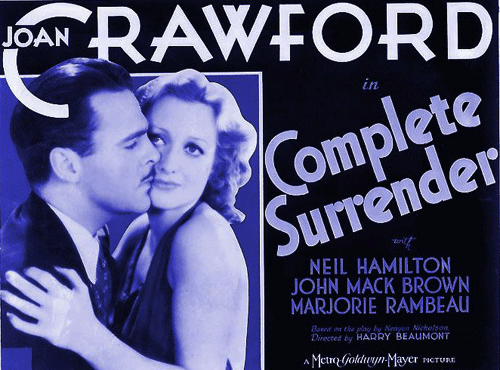
Interesting Trivia
The original working titles of the film was, "Complete Surrender" and "The Torch Song."
Johnny Mack Brown was originally cast and completed all of his scenes as the Salvation Army Officer who saves Joan's life.
All of his scenes were cut and reshot with Clark Gable in his role. Modern sources state that a preview of the film had such
a bad reception that M-G-M production head Irving Thalberg decided to re-shoot part of the picture, replace Brown with Clark
Gable, and release it as Laughing Sinners. This film was one of three in which Gable and Crawford co-starred in 1931, establishing
them as a popular romantic "team," during much of the 1930s. One of the few times we see a clean shaven Clark Gable
on screen. [www.imdb.com].
Clara Blandick was listed in a news item as being in the cast, but, her participation in the completed film has not been
determined.
Songs: "Brighten the Corner Where You Are" words and music by Charles H. Gabriel and Ina D. Ogden; "What
Can I Do?--I Love That Man," words and music by Martin Broones.
Cost: $338K/Domestic Studio Gross: $624K/Foreign Studio Gross: $141K/ Profit:$156K
Box Office Receipts: $10,486,136.84.
Inflation Value in 2007: $15,819,780.60
Photos
Click on images below to see a larger view.
Movie Posters/Lobby Cards etc...
|

|

|
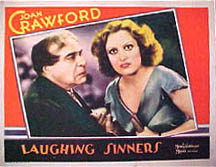
|
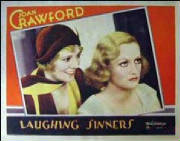
|
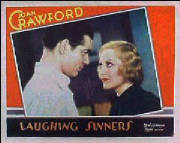
|
|
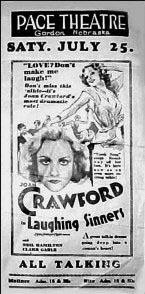
|
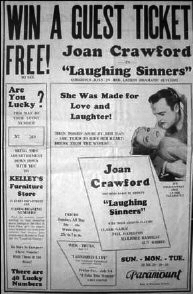
|
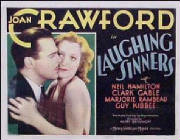
|
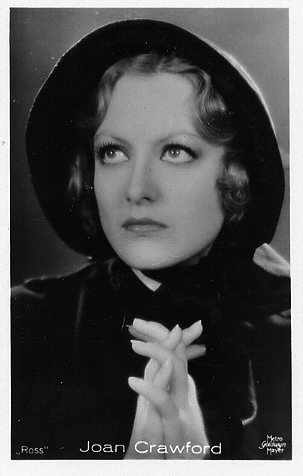
|
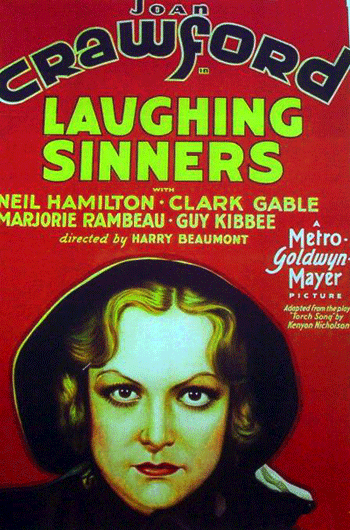
|
|
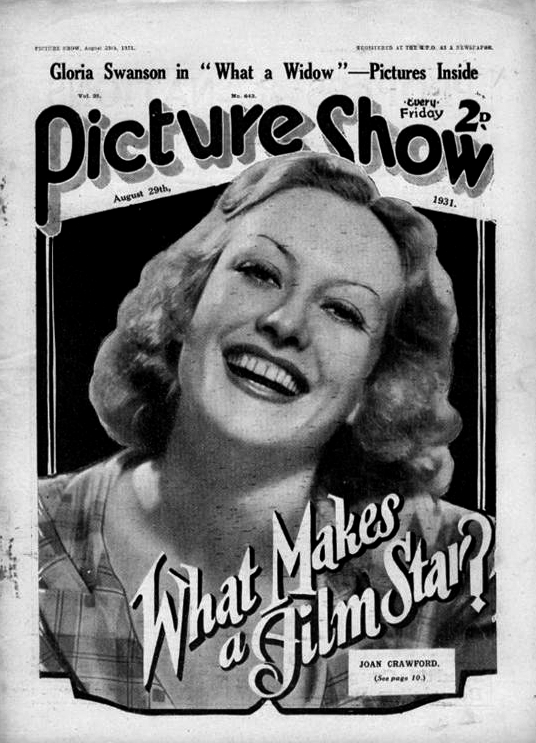
|

Above: Rare sheet music of old movie title and male lead pictured on cover.
|
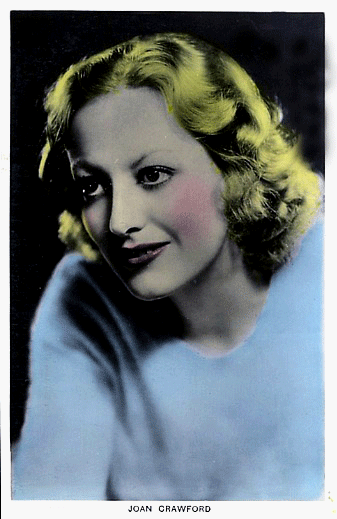
|

|
|
Reviews
Reviewer, Simon Davis, says...
An "oddity", is probably the way many Crawford/'Gable enthusiasts would describe 1931's "Laughing Sinners.
MGM legends Joan Crawford and Clark Gable were famed for creating magic on screen together in their eight teamings from 1931
through to 1940, despite the sometimes average quality of the scripts they had to work with. "Laughing Sinners",
which was their second time together on screen was probably one of their more unusual efforts and came about because of their
dynamic work together in Joan's previous starring effort "Dance, Fools, Dance". In that gangster effort the pair
made a potent combination in their scenes together despite Gable appearing only in a small supporting role. Their obvious
dramatic and sexual chemistry together made MGM follow an unusual course of action whereby they decided to scrap most of the
footage from Joan's currently in production effort titled "Complete Surrender", which had the uncharismatic Johnny
Mack Brown starring with Joan. Instead they largely refilmed what had been already been completed with Clark Gable now playing
the part of the saintly Salvation Army Worker who rescues Joan's character from the seamy side of life not once but twice!!
While it certainly lacks the potency of their sterling work together in their next effort the same year "Possessed",
taken on its own level "Laughing Sinners", is a interesting early snapshot of both Crawford and Gable still in the
process of "creating", themselves and importantly the personas that movie audiences would clamour to see in the
succeeding years when Crawford and Gable together spelt big box Office for MGM.
Based on the stage play "Torch Song", by Kenyon Nicholson the story of "Laughing Sinners", opens with
good time girl Ivy Stevens (Joan Crawford),known as "Bunny", to her friends working as a singer/dancer in a cafe
and having a mostly long distance relationship, with travelling salesman Howard Palmer (Neil Hamilton), who spends his life
always on the road working and sampling the "local ladies", at each of his stopovers. Ivy nevertheless still loves
him but when Howard decides to settle down and marry the "respectable",girl back home Ivy's whole purpose for living
comes crashing down. She attempts to end her life by jumping off a bridge only to be rescued by a Salvation Army Officer named
Carl Loomis (Clark Gable). At first cynical of his purpose in "rescuing", her Ivy begins to see the good in Carl
and the great purpose in his work and before too long she joins the Salvation Army. All goes well for some time until one
evening while conducting one of their group meetings on a street corner Ivy happens to be spotted by Howard who is back in
town on another of his trips. By this time unhappily married Howard is anxious to rekindle something with Ivy and doesn't
for one minute believe her sincerity in getting involved in Carl's work. Ivy, finds herself falling yet again for Howard's
rather questionable charm which results in her getting drunk and spending the night with him. At this moment Carl comes to
see her and an angry confrontation occurs between Howard and Carl after which Carl shows his sincere regard for Ivy by urging
her to try again despite her "lapse", in living a decent life with purpose.Realising Howard will never change, at
the fadeout Ivy returns to Carl and the work of the Salvation Army.
"Laughing Sinners", could be viewed as preposterous hokum however it is the playing of the three leads that
largely holds the film together. Much discussion has been had of Clark Gable being totally miscast here however one must remember
that the "Clark Gable Persona", that movie goers and film buffs know so well now looking back was of course definitely
still only on the drawing board in 1931. Gable did many varied types of roles before he settled into the "Rhett Butler"
type character for which he is so famous today. It is admittedly hard to picture him as a Salvation Army evangelist however
he shows a sincerity in his playing and even in a lesser effort such as this teams very well with Joan Crawford. Joan's famous
1930's working girl making good image was also only being created around this time and interestingly "Laughing Sinners",
captures her during her brief "blonde phase", which gives her a very distinct look that I find very appealing and
which also was used by Joan in her next film (without Gable), "This Modern Age". Joan as always gives her all in
the role of Ivy and while she seems to me to be more at home in the scenes as the part time girlfriend of Neil Hamilton's
character she does display a simple sincerity in those scenes when she joins the Salvation Army and shares scenes with Clark
Gable. Neil Hamilton who of course much later won fame for playing Commissioner Gordon on the television classic "Batman"
in the 1960's does very well as the no good rogue Howard who drives Ivy to attempt suicide . I feel he actually has the male
role with the most dramatic weight to it and he makes an interesting contrast to Clark Gable's character who is so saintly
and unbelievably decent that a bit of "vinegar', really wouldn't go astray to make him a bit more interesting. Being
the early Pre-Code era MGM still surprisingly doesn't hide from showing the raw and often sordid life of the 1930's travelling
saleman and the women who "wait", for them at each of their stops. This type of subject matter and indeed even the
title of this film wouldn't have made it past the censors by the mid 1930's and are perhaps the most vivid images to come
out of "Laughing Sinners", for me. The story despite its "thin", patches doesn't hold back from painting
a rather unsavoury picture of life on the road and the booze, one night stands, and seedy hotels inhabited by men who lead
these rather aimless lives with no firm roots anywhere.
While no great classic "Laughing Sinners" has its interesting points but is most definitely not your typical
glamourous Crawford/Gable picture . It does reveal the great film combination of Crawford and Gable in it's early stages when
they were still looking for a successful formula. I personally love the Pre-Code Hollywood films that really try and show
the often quite ugly underbelly of society at that time life at that time. Certainly "Laughing Sinners", has its
share of unsavoury and unlikeable characters that while not always terribly realistic do give the film that slight hard edge
typical of the early 30's. Definitely worh a look to catch a glimpse of "very early" Joan Crawford and Clark Gable.
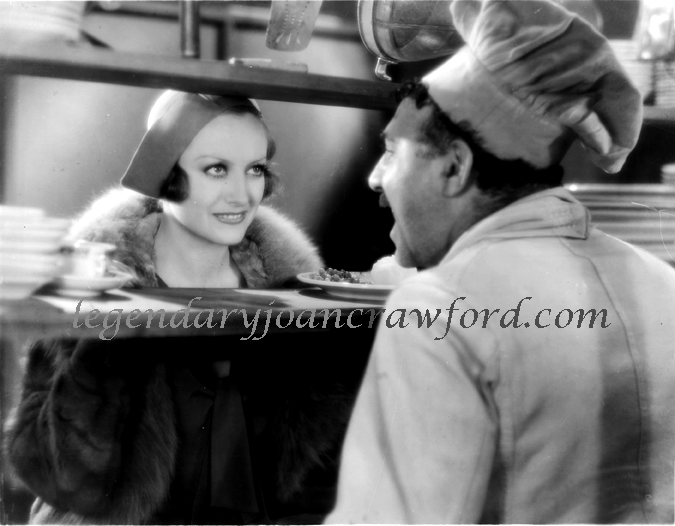
Reviewer, tavm, says...
Laughing Sinners marks the first time Clark Gable appeared in a movie starring Joan Crawford. Crawford is the only name above
the title and Gable is listed third in the cast list after Neil Hamilton (who would be better known as Commissioner Gordon
in the "Batman" TV series). Crawford is a singer/dancer who falls for the traveling salesman Hamilton. He abandons
her while she sings a love song for him. Gable plays a Salvation Army man who saves Joan from jumping off a bridge and convinces
her to join. While she performs on a street corner, Hamilton sees Crawford and convinces her to stay in his hotel room. I'll
stop right there and mention who else is in this movie: Guy Kibbee, Roscoe Karns, Cliff Edwards before he became the voice
of Jiminy Cricket in Pinocchio, and, in a nice picnic scene with Gable and Crawford, Our Ganger Mary Ann Jackson, hair bob
and all. There are some entertaining musical numbers danced by Crawford including an amusing sequence of Joan dressing as
a farmer with funny nose and beard. Other than that and the picnic scenes, this is a pretty talky picture that reveals its
stage origins too clearly toward the end so you may feel bored after a while. Still, an interesting curio for fans of all
the above players.
Three Stars

Other Reviews
A. D. S. of the "New York Times" had this to say, "Miss Crawford has seldom looked so radiantly alive and beautiful;
she has tempered the intense and not a little self-conscious quality of her acting without hurting her vibrant and breath-catching
spirit. In the cabaret scene she gets through her dancing scenes in excellent fashion and even manages a torch song called
'What Can I Do? - I Love That Man!' very commendably."
TV Guide says, "LAUGHING SINNERS had already finished shooting when the studio bosses saw the response to Gable as
Crawford's man in DANCE, FOOLS, DANCE, so they cut all the already-shot footage with Johnny Mack Brown and reshot the scenes
with Gable, who was billed under Neil Hamilton. Crawford is a nightclub thrush who gets tossed aside by a shifty traveling
salesman, Hamilton, whom she thinks the sun rises and falls upon. When he dumps her, she thinks there's nothing left to live
for so she takes a dive off a bridge into the local river. Gable, a Salvation Army worker, saves her and begins to redo her
life. Under his tutelage, she forswears the nightery existence and begins to work next to him in his evangelistic occupation.
Soon enough, she's also in uniform, pounding the tambourine on street corners. All is well until she again meets Hamilton
at a local hotel and her passion for him outstrips her good sense. It isn't long before she's in Hamilton's power. Gable breaks
in on the two of them, knocks Hamilton for a loop, then says he's willing to take Crawford back into his life if she's willing
to try it again. Crawford understands that a life with Hamilton would be likely to put her back in the river she'd been rescued
from in reel one, so she tosses him aside and goes off with Gable. The picture was originally released as COMPLETE SURRENDER
before Thalberg saw sparks in the Crawford-Gable combination and ordered the new scenes. The two were having an off-screen
romance at the time and that could readily be recognized on the screen. Crawford was a blonde for LAUGHING SINNERS and, as
a woman of easy morals, was in training for the part that would make her an international star in RAIN, the following year.
"What Can I Do? I Love That Man" is sung well by Crawford, who was a musical performer before giving her vocal cords
a rest as a dramatic actress. The play upon which this was based was not a hit, so one wonders why they chose to make it as
a film." - 2 stars
crazy4cinema.com says, "This rather obvious tale of redemption would have disappeared long ago if it weren't for the
big name talent involved. Crawford gives an engaging performance as a simple chorus girl who tries to end her life after her
salesman boyfriend Howard (Hamilton) gives her the old heave-ho to marry his boss's daughter. Ivy (Crawford) is devastated
by his desertion and saved from mortal harm by a passing gentleman. Carl (Gable) is a Salvation Army preacher who gives her
something deeper to live for. Espousing her old life of wanton sex, cheap booze and sleazy dance halls, she becomes a do-gooder,
using her energy to help those less fortunate than herself. She finds comfort and satisfaction in her work until she runs
into Howard, who is stunned at the change in her lifestyle. She tries to ignore him, but eventually succumbs to his advances,
wanting to feel desired and loved again."
"She initially agrees to chuck her new life for a return to Howard's arms, but Carl's unwavering, yet platonic, love
quickly snaps her back to reality. With her head out of the clouds, she sees what a selfish bastard her lover is, wanting
her to accommodate his schedule and desires, giving no thought to her future or feelings. While constantly being a good girl
can be boring, being someone's plaything is no longer an acceptable option to her. She's found acceptance and self-worth and
no one, even the love of her life, is going to take that away from her. While a positive message, the execution is highly
heavy-handed and clearly meant to convince the young women of the day to stay on the straight and narrow. Crawford gives an
admirable performance, strongly portraying both sides of the lifestyle coin. She's just hampered by the film's blatant moralistic
stamp."
"Ultimately, her conversion from bad to good lacks the conviction needed to turn this tale of redemption into something
with true depth and honesty. She isn't a total slut in the beginning, just a girl who was sleeping with the man she loved.
Granted they weren't married, but that's not much of a social faux pas to modern audiences, which is why the story often seems
strident and preachy. Her transformation into a god-fearing woman is handled with simplicity and conviction, her about-face
back into a wanton woman less so. Apparently, the filmmakers thought we needed one more look at sexy Joan. Audiences weren't
paying to see her be demure. In the end, what saves this film from obscurity is Crawford's energy and earnestness."
"If you blink, you'll miss Gable. His is the voice of reason in this tale and through he's successful in saving Crawford,
I almost wish he wasn't. His character is awfully one-dimensional, too simple-minded in his devotion to others to be believed.
He's like the good angel sitting on her shoulder and his constant piety got on my nerves. This has to be one of his few true
nice guy roles and now I know why. I like my Gable characters to be charming and a bit sleazy. Here he's just a good-hearted
nerd. Thankfully, the film industry quickly found better uses for his talent. SINNERS is a mediocre melodrama that won't bring
new fans to either stars fold nor convince many viewers to watch more early cinema."
If you have seen this movie, please write a review below. Once your review is submitted, I will post the review below. Thank
you for your review on this film.
Click on the decades below to browse movies.
|

